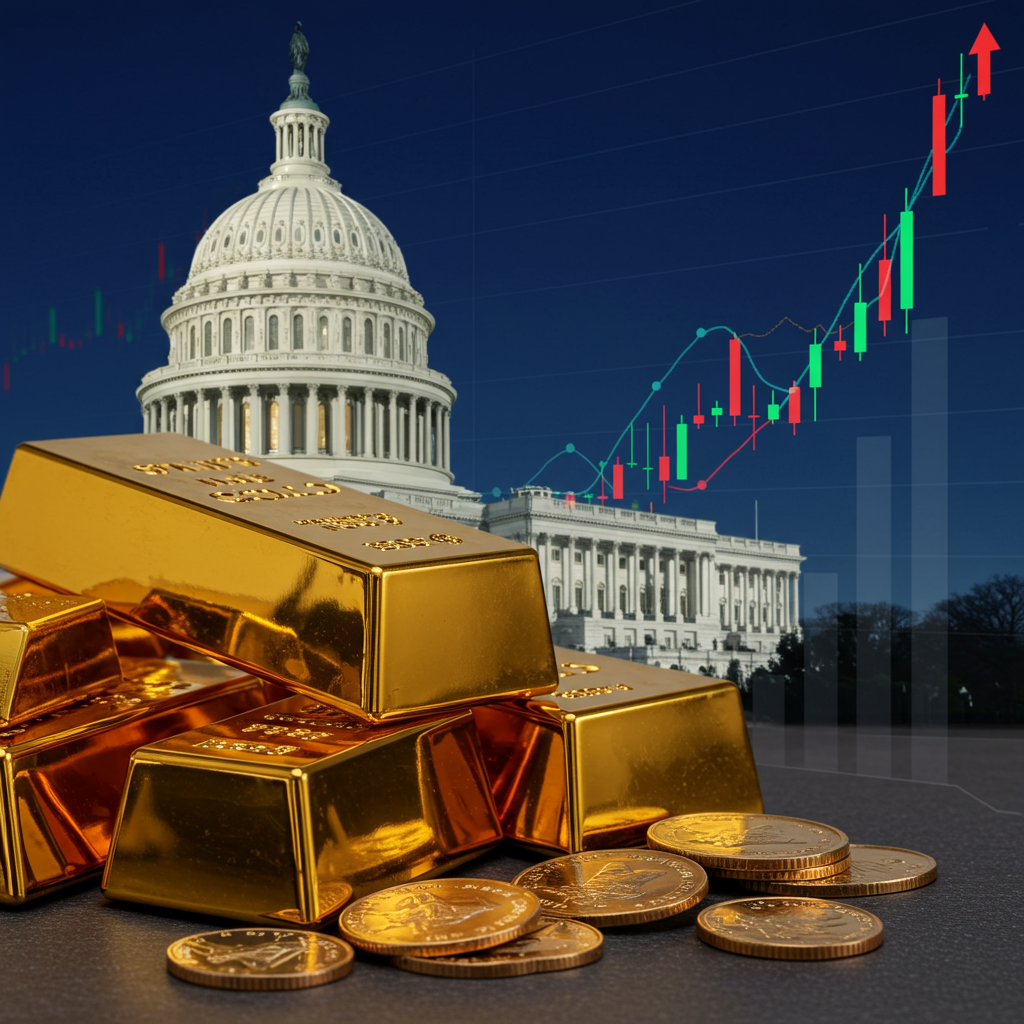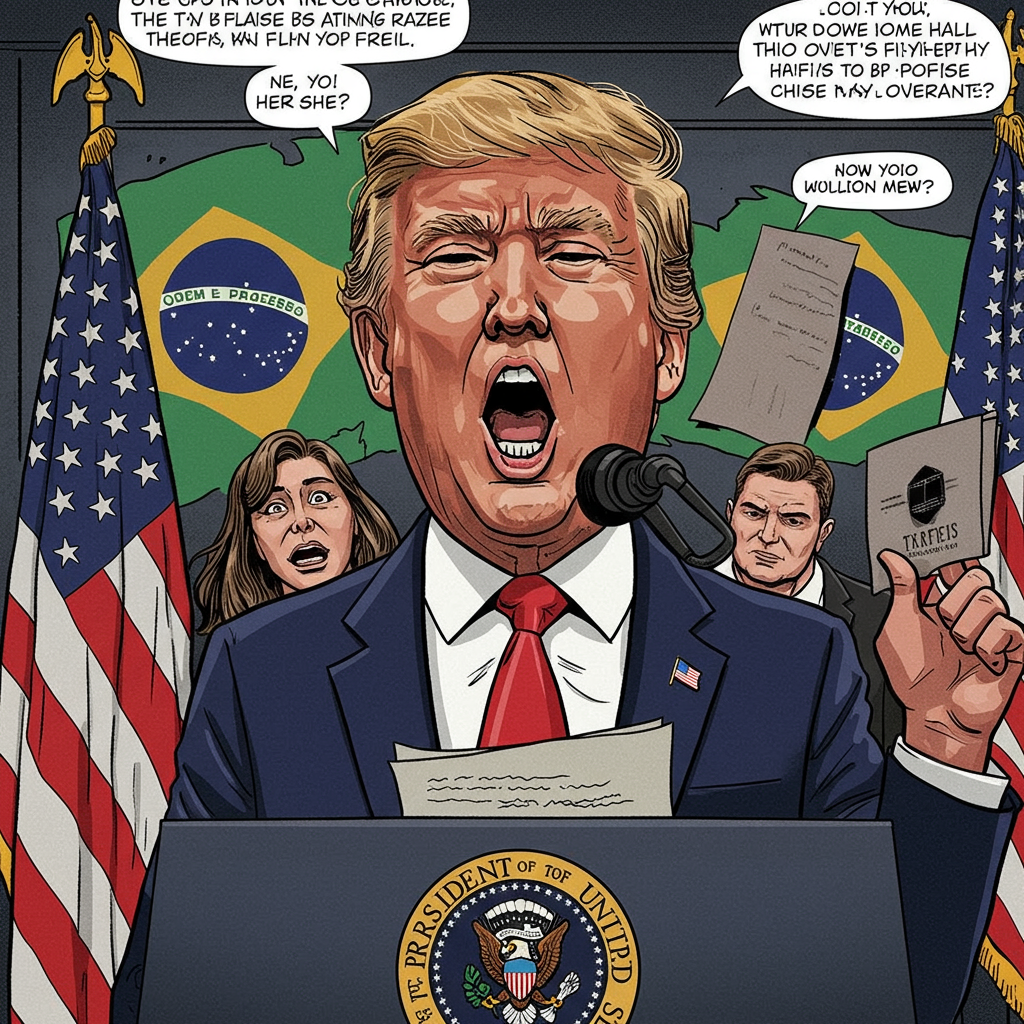Gold has surged to an unprecedented all-time high, fundamentally shifting its position in global financial markets. This remarkable rally, pushing bullion past $3,895 an ounce, coincides directly with the US government entering a shutdown on October 1, 2025. This event, the first in seven years, has amplified economic anxieties and propelled investors toward the yellow metal’s perceived safety. As the dollar weakens and crucial economic data faces delays, gold’s appeal as a premier safe-haven asset has never been clearer.
The Spark: US Government Shutdown Fuels Gold’s Rally
The financial world closely watched as the US government officially began its shutdown on Wednesday, October 1, 2025. This gridlock followed the failure of a crucial stop-gap funding package in Washington, triggering widespread concern. Government agencies received White House instructions to “execute their plans for an orderly shutdown.” This abrupt halt to federal operations immediately sent ripples across markets. The US Dollar, alongside equity-index futures, experienced declines, signaling investor unease.
A primary consequence of this political stalemate is the threat of delayed economic data releases. Key reports, such as the highly anticipated non-farm payroll numbers, face suspension. This potential information vacuum exacerbates market uncertainty. For investors, gold becomes a beacon in such turbulent times, offering stability when traditional markets appear volatile.
Beyond the Shutdown: Macroeconomic Winds at Gold’s Back
While the US government shutdown provided the immediate catalyst, gold’s record-breaking ascent is underpinned by a powerful confluence of macroeconomic factors. These broader trends have been building throughout 2025, setting the stage for gold’s spectacular performance.
Fed Rate Cut Expectations Intensify
Expectations for further Federal Reserve interest rate cuts are a significant tailwind for gold. Traders now price in a 95% probability of a 25-basis-point (bps) rate cut in October. An 87% chance for another cut in December further strengthens this sentiment, according to the CME FedWatch tool. Lower interest rates typically reduce the opportunity cost of holding non-yielding assets like gold. This makes bullion more attractive compared to interest-bearing investments.
Federal Reserve officials have offered nuanced perspectives. Boston Fed President Susan Collins suggested easing policy “may be appropriate” if data supports it. Dallas Fed President Lorie Logan, however, cautioned about “relatively little room” for additional cuts. Fed Vice Chair Philip Jefferson remained non-committal, acknowledging pressures on both sides of the Fed’s mandate.
A Weakening Dollar’s Influence
The US Dollar has been in a sustained downtrend, a trend exacerbated by the political deadlock. The US Dollar Index (DXY) recently slipped to its lowest level in a week, around 97.80. A weaker dollar makes dollar-denominated gold more affordable and appealing for international buyers. This inverse correlation is a fundamental driver of gold’s price movements.
Haven Demand Amidst Central Bank Tensions
Lingering concerns regarding the central bank’s independence have also boosted safe-haven demand. Recent events, like the US Supreme Court’s refusal to allow President Donald Trump to immediately remove Federal Reserve Governor Lisa Cook, underscore this tension. This ruling was a setback for Trump’s efforts to exert greater control over the Fed, ensuring Cook’s tenure. Further, Trump’s public criticism of Fed Chair Powell as an “OBSTRUCTIONIST” on social media highlights this ongoing struggle. Such political interference with central bank autonomy can push investors towards neutral assets like gold.
Global Instability and Inflation Concerns
Persistent global inflation concerns and mounting geopolitical tensions, particularly involving Russia and NATO, add another layer of uncertainty. Historically, periods of high inflation and international conflict drive investors to gold as a reliable hedge against economic instability and currency debasement. The current environment mirrors precedents like the 1970s oil shocks and the post-2008 financial crisis.
The “Golden Surge”: Record-Breaking Performance
Gold’s journey in 2025 has been nothing short of extraordinary. On October 1, it touched a new all-time high of $3,895.38 an ounce, marking its fifth consecutive day of rallying. This monumental ascent represents gold’s best monthly performance in over a decade, with gains exceeding 11% in September alone. Since the start of 2025, gold has soared over 46%, positioning itself for its largest annual gain since 1979.
This “Golden Surge” has pushed gold futures near the $3,900 mark, a level once considered a distant aspiration. Analysts now widely anticipate the rally to continue, with some major banks forecasting prices to reach $4,000 per ounce by late 2025 or mid-2026. This sustained momentum reflects a fundamental re-evaluation of gold’s role in diversified portfolios.
Key Players Driving Demand
The surging demand for gold is not accidental; it’s fueled by significant institutional and individual investor behavior. Understanding these key players provides insight into the enduring strength of the gold market.
Central Bank Activity
Central banks globally are among the largest and most consistent buyers of gold. They use bullion to diversify reserves and bolster the perceived strength of their economies and currencies. In 2022, central banks added a record 1,136 tonnes of gold to their reserves. This trend signifies a broader de-dollarization movement, with nations like China and Russia actively increasing their gold holdings to reduce reliance on the US dollar. This fundamental shift provides strong underlying support for gold prices.
Investor Influx into ETFs
Institutional and retail investors are pouring significant capital into gold-backed Exchange Traded Funds (ETFs). September saw the largest monthly ETF inflows in three years, attracting approximately $10.5 billion. This widespread buying demonstrates increasing investor interest and a fundamental shift in asset allocation strategies, indicating a flight to quality amidst market uncertainty.
Silver and Other Precious Metals Follow Suit
The robust performance isn’t limited to gold. Silver, a related precious metal, has also experienced a significant jump. It rose as much as 2.5% to $47.8290 an ounce, putting it less than 4% shy of its own all-time high. Silver’s performance has been even more impressive this year, climbing over 60%. Its gains are underpinned by similar macro factors driving gold. Additionally, persistent market tightness resulting from several years of supply deficits is finally coming to a head, further boosting silver’s appeal.
In contrast, other precious metals like platinum and palladium have recorded declines, highlighting gold and silver’s unique safe-haven status in the current climate.
Understanding Gold as a Strategic Asset
Gold’s enduring appeal stems from its fundamental characteristics as an asset. It serves as a reliable store of value, particularly during turbulent economic times. Investors consider gold a critical safe-haven asset, offering protection against inflation and depreciating currencies. Unlike fiat money, it is not tied to any specific government or issuer.
Gold typically exhibits an inverse correlation with the US Dollar and US Treasuries. A strong dollar generally keeps gold prices in check, while a weaker dollar fuels its ascent. It also moves inversely to risk assets; a stock market rally tends to weaken gold, while sell-offs in riskier markets favor it. The current environment, characterized by high inflation, persistent conflicts, and unprecedented fiscal and monetary policies, strongly resembles historical periods where gold proved its value as an inflation hedge and crisis-era asset.
Market Implications: Winners and Losers
The unprecedented rise in gold prices creates clear winners and losers across various industries.
Winners in the Golden Rally
Gold mining companies are the primary beneficiaries of this surge. Companies like Newmont Corporation and Barrick Gold Corporation are experiencing significant boosts to revenues and profitability. This occurs because extraction costs remain relatively stable while selling prices soar. Higher stock valuations, increased dividends, and expanded exploration budgets are likely outcomes for these firms. The rally also encourages increased investment in mining exploration and development, benefiting related service providers.
Potential Headwinds
Conversely, companies heavily reliant on a strong US dollar or those with significant import costs may face headwinds. Industries using gold as a raw material, such as jewelry manufacturers or electronics companies, face increased input costs. This can potentially squeeze profit margins. The high price also raises the bar for new mining projects, possibly leading to consolidation within the junior mining space.
Looking Ahead: Gold’s Enduring Role
Gold’s path appears poised for continued strength. Sustained US dollar weakness from anticipated Fed rate cuts and ongoing fiscal concerns will likely remain key drivers. Geopolitical events and the specter of continued US government instability will continue to fuel safe-haven demand, pushing prices toward and potentially beyond the $4,000 per ounce mark.
Long-term prospects for gold are further bolstered by the ongoing de-dollarization trend. Gold is regaining its historical prominence as a neutral reserve asset. This institutional demand, coupled with investor flight to safety, suggests a structural shift rather than a transient speculative bubble. Investors may consider increasing exposure to physical gold, gold-backed ETFs, and shares of well-managed gold mining companies. Opportunities could also emerge in related precious metals like silver and platinum. However, an unexpected strengthening of the US dollar or a resolution of geopolitical tensions could pose challenges to this upward trajectory.
Frequently Asked Questions
Why is gold considered a safe-haven asset, especially during a US government shutdown?
Gold earns its “safe-haven” reputation because it’s a tangible asset with intrinsic value, independent of any government or currency. During a US government shutdown, political uncertainty surges, economic data releases are delayed, and the dollar may weaken. These factors create instability in traditional markets like stocks and bonds. Investors then flock to gold as a reliable store of value, expecting it to retain its purchasing power when other assets falter.
What other factors are driving gold’s record-breaking rally in 2025?
Beyond the US government shutdown, gold’s rally is fueled by several macroeconomic forces. Expectations for multiple Federal Reserve interest rate cuts make non-yielding gold more attractive. A weakening US dollar lowers gold’s price for international buyers. Persistent global inflation fears, geopolitical tensions (like Russia-NATO), and strong buying by central banks as part of a de-dollarization trend all contribute. Additionally, significant inflows into gold-backed ETFs reflect increasing investor confidence in bullion.
How might the US government shutdown and Fed rate cut expectations impact gold investors?
For gold investors, the US government shutdown primarily creates market uncertainty, boosting demand for safe havens. This can lead to short-term price volatility but generally supports gold’s upward trend. Expectations of Fed rate cuts reduce the opportunity cost of holding gold, making it a more appealing investment. This combination suggests a favorable environment for gold, potentially driving further price appreciation. Investors should monitor these drivers as well as geopolitical developments and dollar strength when making investment decisions.
The record-breaking ascent of gold in late 2025 underscores its enduring significance as a critical asset in an increasingly volatile world. Its reinforced status as the premier safe-haven, the acceleration of de-dollarization trends, and the growing importance of tangible assets in diversified portfolios are crucial takeaways. Gold is poised to continue playing a pivotal role as a hedge against inflation and currency depreciation, offering a fundamental store of value. Investors must closely monitor central bank policies, geopolitical developments, and currency movements to navigate this dynamic landscape.




